Social media is typically thought of as where all the cool kids hang out. Fast food, clothing, and entertainment all have it easy when it comes to making friends and getting retweets, but businesses in seemingly boring industries frequently settle for mediocrity out of the belief they can’t keep up with the “cooler” industries. But, Uri Bar-Joseph showed us five companies that shrug off the assumption that “boring” businesses can’t be exciting online.
Tag Archive for: social media
All week we try to keep you up to date with the most important SEM news across the web, but inevitably there are smaller stories that fall through the cracks. That’s why we compile all the most important news we missed this week all in one convenient place every Friday. Despite the distractions of the world cup, there have been some pretty big announcements throughout the week. So, let’s get to it.
Google Preps Online Retailers With Best Practices

With the clock ticking before Shopping Campaigns becomes the default campaign type for running Product Listing Ads at the end of August, Google is trying to help prepare retailers and marketers by issuing best practice guidelines to help everyone make the transition smoothly.
For the most part, the guidelines listed aren’t far off from the original PLA recommendations. Yes, the paper covers product feed optimization and newer updates, but most of it is a refresher for those who have been working with retailers for a while now, including classic rules like “use relevant titles and high quality images.”
However, marketers and retailers may be interested in the new recommendations about how to structure new shopping campaigns, especially as we enter the transition period.
You can download the whitepaper of the guidelines from Google here.
Sneak a Peak at Google’s New Reconsideration Rejection Forms
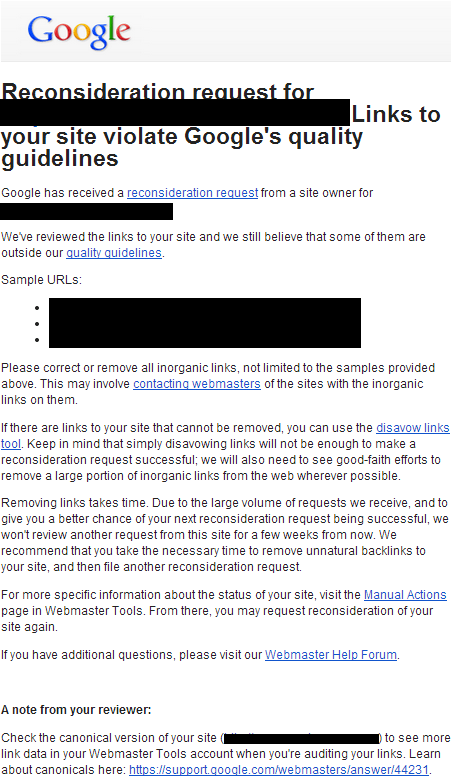
Last week, Matt Cutts made headlines throughout the SEO community by announcing that Google will be revising their reconsideration requests rejection notices with more detailed information in some cases. Of course, there were plenty of skeptics, but an example of the rejection notices has been shared on Twitter by @johnwarddoyle.
Surprisingly, it seems Google made good on their promise.
Don’t get too excited. The individualized response is short and easily missed, but rejection notices at least offer some useful information for repairing a site now. Largely the note is the same as before, but down at the bottom you will see a new section titled “A note from your reviewer.” Here, you will find specific advice relevant to your site that could be potentially highly useful.
Facebook Shows Off Their Snapchat Competitor

After having a $3 billion offer refused by Snapchat – the popular self-destructing photo messenger app – Facebook is trying to fight back. This week Facebook announced Slingshot, an app obviously influenced by Snapchat’s concept, but with a new twist.
Slingshot does allow users to send photos or short video messages that will delete automatically after a short period of time, but there is more to it:
To get started on Slingshot, shoot a photo or video… add some text and color, then sling it to a bunch of friends. Here’s the deal: friends won’t be able to see your shot until they sling something back to you. They can then reply with a reaction – or simply swipe your shot away.
The concept encourages reciprocal communication more and could potentially catch on, but it could just as easily fall apart in the shadow of it’s better-established rival. With the faltering youth activity on Facebook, it is hard to know how much traction this type of app can get.
Major Brand’s Seeing Engagement Plummet on Facebook
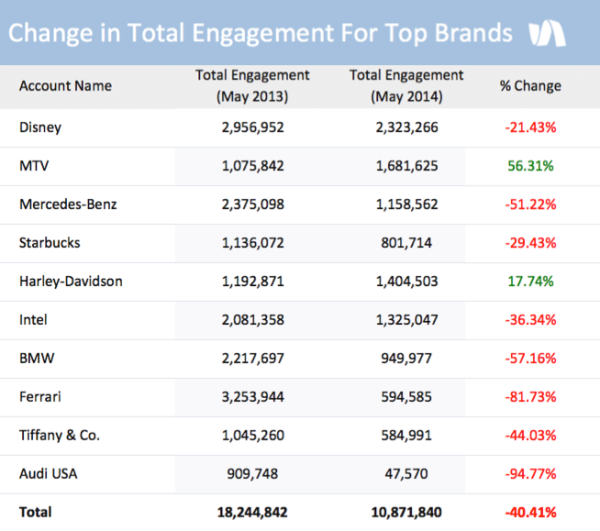
Speaking of Facebook’s problem of bleeding activity and user engagement, recent reports show that it isn’t just the teen demographic evaporating from the site. Facebook analytics provider Simply Measured says consumer engagement with Facebook posts from almost all top Interbrand companies are down significantly from last year.
According to the firm, monthly engagement is down over 40 percent since May 2013.
Only two brands on the list (MTV and Harley Davidson) say increases in engagement, while the others saw huge decreases. Overall engagement was down at least 50 percent.
Most troublesome for Facebook, the report outright cites the decreasing organic reach available on Facebook as a primary blame for the decline in engagement.
Facebook’s Graph Search Makes Its First Appearance on Mobile

While Facebook’s Graph Search hasn’t been officially released on mobile yet, but it is most likely getting very close to being rolled out. Over the past week, many people reported encountering a test showcasing in-depth integration for the Graph Search for mobile users with all the same features you’ve come to recognize.
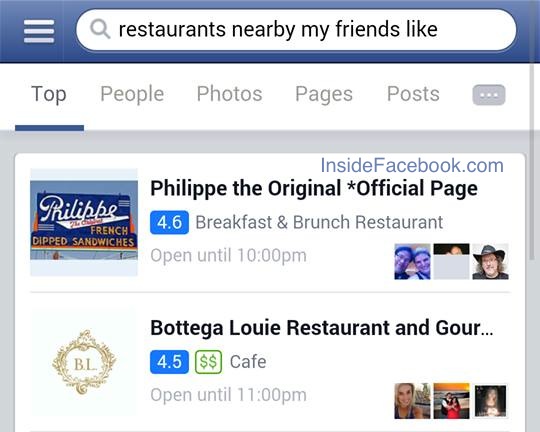
The most anyone has gotten out of Facebook is the response “we’re testing improvements to Facebook mobile search.” But, I would wager the release will be sooner than later. The current testing version for mobile seems to be able to handle all the complex searches capable on desktop and appears to be largely ready for release.
Twitter Finally Adds Animated GIF Support
Twitter’s announcement this week may seem super minor, but it has received nearly as much coverage this week as any other bit of information relevant to online marketing. The reason is simple: internet users love GIFs and this week Twitter announced you can now post and view animated GIFs on Twitter’s website and mobile apps.

Of course, the announcement came in the form of a Tweet featuring an animated GIF from Twitter Support.
Starting today, you can share and view animated GIFs on http://t.co/wJD8Fp317i, Android and iPhone. pic.twitter.com/XBrAbOm4Ya
— Twitter Support (@TwitterSupport) June 18, 2014
Previously, users could share links to GIFs via third-party services like Imgur, but starting this week you can now share and view the moving images directly on Twitter.
Importantly, GIF’s won’t start playing automatically in your feed like they do on Tumblr. Instead, when a GIF is shown, a white play button will be overlayed, allowing you to choose when a GIF starts playing.

Source: Jason Howie
Marketers have overwhelmingly confirmed that social media is a highly valuable target for campaigns of all shapes and sizes, but you have to be able to effectively aim your message. If your social marketing strategy is out-dated or unfocused, then it will never gain traction on any of the major social platforms.
Social Media Examiner recently released its annual Social Media Marketing Industry Report, based on surveying more than 2,800 marketers. If you want to make sure you are up to date with the state of social media and guarantee you are sending out the right message to the right people, you’ll want to know these important trends highlighted by this year’s report.
1. Blogging is Back – It should be obvious by the widespread cries of “Content is King!” over the past year, but blogging is all the rage yet again. The report shows this blogging is only going to get more popular looking forward as 68 percent of marketers said they would be increasing their blogging efforts. That is the most attention blogging has received since 2010 according to the report.
2. Facebook is Showing Its Age – Compared to the relatively short lifespans of popular social media platforms like Myspace, Facebook’s reign at the heights of social media has been extremely long. But, the report supports numerous claims over the past year that Facebook is beginning to lose users and marketers alike. Despite still being the most important social network overall, by a significant amount, only 43 percent of marketers feel their efforts are effective and 7 percent intend to decrease their use of Facebook this year.
3. Google+ is Finally Getting Some Attention – Despite still being the source of plenty of derisive jokes, Google+ is finally seeing some light on the horizon. The report explains, “While 54 percent of marketers are using Google+, 65 percent want to learn more about it and 61 percent plan on increasing Google+ activities in 2014.”
4. Is Podcasting the Next Big Thing? – Only 6 percent of marketers are currently involved in podcasting, but expect to see efforts skyrocketing soon. The report says 21 percent of marketers are planning on increasing their podcasting activities this year. Many also showed heightened interest in podcasting, with 28 percent saying they wanted to learn more.
Are you trying to stay on the cutting edge of social media? It is hard to stay ahead of the curve, but with enough effort you can corner all the new emerging platforms while keeping up with the content trends.
With the constant stream of information coming out of the online marketing industry, it can be hard to keep up with all the latest updates without missing some important news. That’s why we compile all the biggest stories you may have missed this week all in one convenient place every Friday. This week, Pinterest dominates headlines. Let’s get started:
Pinterest Finally Starts Paid Test of Promoted Pins

Last fall, Pinterest announced they would be making their first foray into paid ads on the social media platform under the title of “Promoted Pins”. They ran some tests shortly after the announcement to gauge how their users responded to the ads. Now, Pinterest declared they have officially begun a small paid test of the Promoted Pins while working with a small group of brands from the U.S. The test will only be shown in Pinterest’s search and category fields.
Pinterest lists the entire list of brands taking part in the test, including ABC Family, Banana Republic, GAP, and Walt Disney Parks and Resorts. If you do happen to catch one of the Promoted Pins being tested, Pinterest would like users to give feedback via a form found here.
Pinterest Reveals the Most Popular Categories On Each Day of the Week
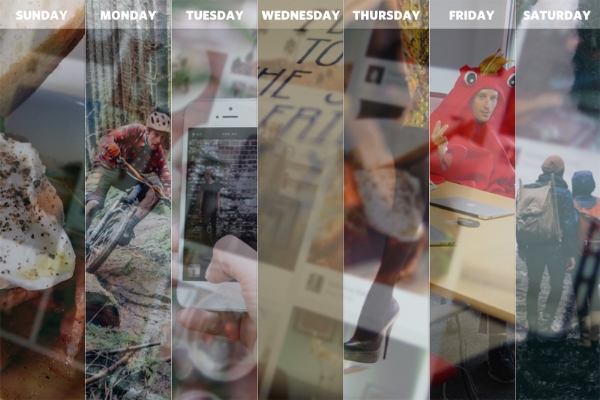
Just about every social media platform has their own mini-trends that influence what type of content gets shared the most at a certain time. Facebook users follow predictable patterns of usage times and the success of content on Reddit is partially decided by the “prime sharing times” when users are more likely to see new content. Similarly, Pinterest recently shared a post on their blog detailing the most popular categories for each day of the week.
4 Statistics About Pinterest You Need to Know
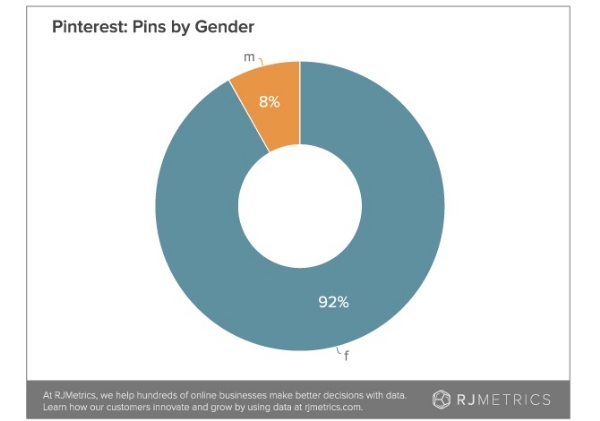
On the topic of Pinterest trends and data, RJMetrics recently ran a study of 50,000 random pinners and their pins to analyze how people are using Pinterest. At first glance, the data may seem like old news, however the details found in the study give strong insight into what pinners are interested in, what they are likely to share, and when they are most likely to Pin. For example, it is no secret that the majority of Pinterest’s users are female, but it may come as a surprise that around 80 percent of pinners are female, and an whopping 92 percent of all pins on the site come from women.
You can get all the details from the study in RJMetrics’ report on their site.
Google Maps Adds Location Based Quick Facts
Yesterday, Google announced via Google+ that they have added a new section on map results for location searches named “Quick Facts.” As many have pointed out, the section looks quite similar to the Knowledge Graph that appears on some Google searches, and has the same type of very quick information about the area you are searching for. The Quick Facts are pulled from Wikipedia and other data sources typically used in the Google Knowledge Graph.
You can get an idea how the Quick Facts operate thanks to the example Google released of the results for Angkor Wat in Cambodia below.

Twitter Introduces a Mute Button To Quiet Individual Users
Earlier this week, Twitter revealed they will be adding a new feature for its iPhone and Android apps, as well as Twitter.com, which allows users to mute specific people and forbid their tweets from appearing in your timeline. You can mute users two different ways. You can either mute a user from a Tweet by clicking on ‘more’ followed by ‘mute @username’ or you can mute users from their profile page.
When a user is muted, their Tweets and Retweets will be no longer visible in your home timeline and you won’t receive push notifications if you previously set up that feature for the user. However, the muted user will still be able to see, face, reply to, and retweet anything you share. From the muted users perspective nothing will have changed.
You will be able to unmute users at any time and the new feature is expected to be rolled out in the next few weeks.
Facebook and Twitter See Slightly Less Global Usage While Instagram and Tumblr See Big Increases
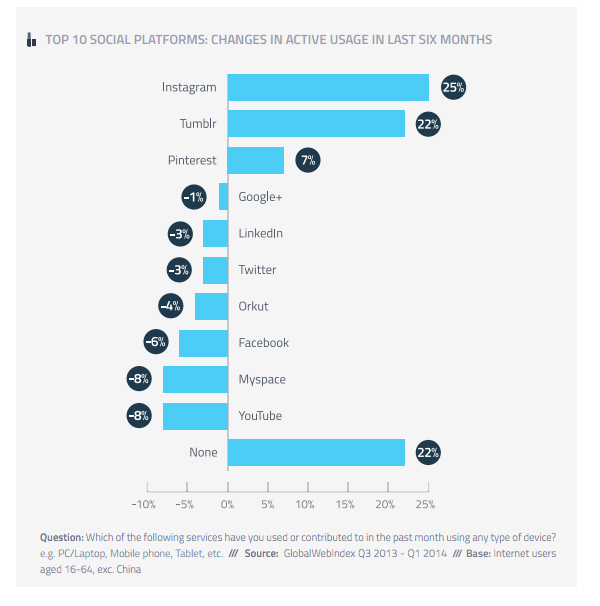
Facebook and Twitter still hold a strong hand on the social media landscape/ However their grasp may not be safe forever as new survey data from GlobalWebIndex shows a slight reduction in usage for both networks over the past six months. They Facebook may not be too nervous yet. The survey of more than 40,000 internet users in 32 global markets, excluding China, found that as much as 82% of users worldwide have Facebook accounts.
However, several reports suggest the small dip in usage may be an indicator of a growing trend within Facebook, opening the door of opportunity for smaller and more focused social platforms such as Instagram and Tumblr.
The survey also found a significant growth in the use of mobile apps. Out of all apps, Snapchat saw the biggest rise in use as it is accepted by more and more teens worldwide. You can download the full report from GlobalWebIndexhere, but Martin Beck also summarizes the findings over on Marketing Land.
Search engines and social media are battling for the top spot as the leading source of referral traffic to publishers on the web. Recent accounts suggested that social media may be taking the lead.
However new data from Parse.ly, a content analytics platform that counts Reuters, Mashable, Slate, and The Next Web among its many clients, shows that search has retaken the lead from social media as the top source of referral traffic in March of this year.
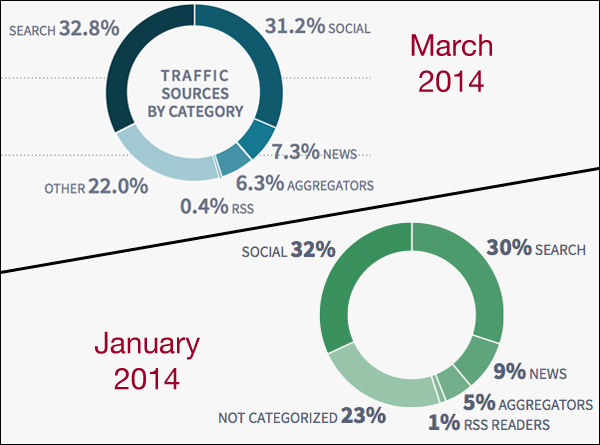
Parse.ly’s publishers saw 32.8 percent of its traffic coming from search in March, compared to 31.2 percent from social media. That is the exact reverse of results from data, when data showed social traffic outdid search 32 to 30 percent.
Overall the trends still favor social media, despite the good month for search in March. If you look at reports from further back, it becomes clear that search has been steadily losing ground. In October 2013, Parse.ly reported search was by far the dominant source of traffic at 36 percent, compared to only 22 percent for social.
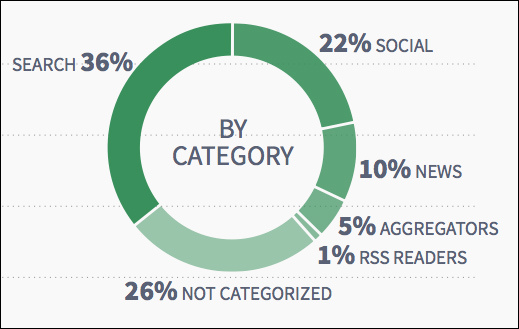
Google sites were still the No. 1 overall source of traffic for the analytics platform’s clients during the most recent reporting period, with Facebook coming in second. Those two net giants were significantly higher sources than any other individual sites.
More than a few online marketers are ready to declare desktop search to be dead, as the internet works to integrate platforms more than ever. But while mobile traffic is becoming an ever more important part of the search world, ignoring desktop internet usage could be a huge mistake.
One of the most important metrics for many online businesses are marketers is engagement. When you share something on your site or through Facebook or Twitter, the goal is naturally to interact with others. Sure, plenty of people spew out content without ever actually interacting, but anyone who takes social media and online interaction seriously knows that real engagement is what happens after you’ve shared.
Publishing and sharing content has tons of benefits, but users gain a better idea of who the company they are interacting with through commenting, messaging, and truly engaging a discussion. Consumers have shown more and more that they are looking for brands with a face, or at least a Twitter personality.
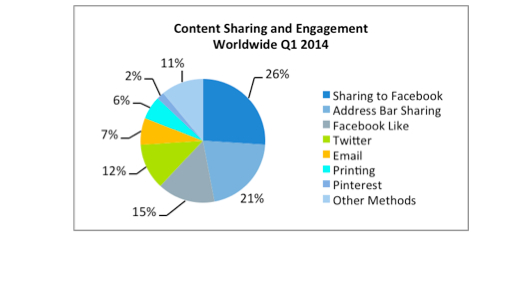
However, if you are marketing directly towards a mobile users or you are writing up a death certificate for mobile search, you likely aren’t getting as much as engagement as you could. A new study has shown that desktop users are the dominating force behind content sharing and engagement around the world.
The mobile share of total engagement has been increasing, but the latest data from AddThis still shows a 65%-35% advantage for desktop. There are many possibilities for the cause behind the disconnect. Martin Beck suggests the driving force is publishers who haven’t optimized content and engagement services for small screens, but that doesn’t explain away the differences observed on mobile optimized platforms such as Facebook and Twitter.
More likely, the differential is created by different usage patterns across platforms. Mobile users are more likely to look up brief facts and information, but content that calls for engagement also often necessitates more thought and time to read. Quite simply, most people are more likely to do their reading, bookmarking, sharing, and commenting from the comfort of a desk.
It appears we are currently in redesign season for most major search engines and social media platforms. Over the past month, Google and Bing have announced redesigns of their search results pages (Bing’s is still in testing, but has been confirmed). Meanwhile, Facebook rolled out the latest version of their site, and now Twitter has announced a new design for profile pages, complete with a slew of new features.
It seems obvious that one of the major motivators for the redesign was to improve organization of the site. Marketing Land recently conducted a study that found one of the biggest reasons for people to quit Twitter was the lack of sorting, filtering and media, which are all major focuses of the new layout.
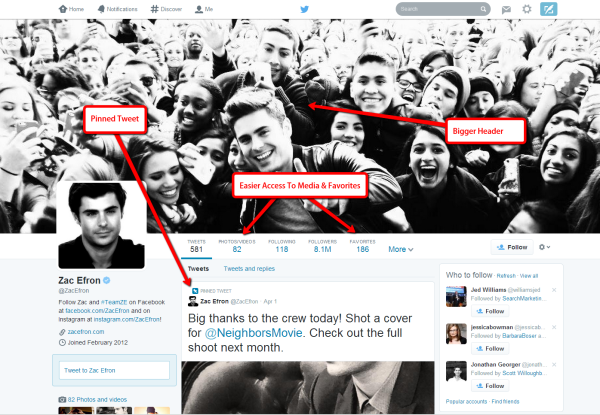
Source: Marketing Land
The biggest and most notable change however, is the huge profile header that spans the full width of the screen. The huge header is easily the biggest visual change, but the most important updates all fall below. The new features allow users to pin Tweets to the top of the page, which is the first feature that allows users to break the chronological flow of their page ever. You can also filter the tweets you view by three categories:
- Tweets
- Tweets and Photos/Videos
- Tweets & Replies
One of the last updates is a bit more subtle than the rest. Tweets with more engagement have gained more prominence on the screen as fonts get bigger based on activity. The Tweets getting the most attention get bigger, while less popular updates will continue to be shown at the normal font size.
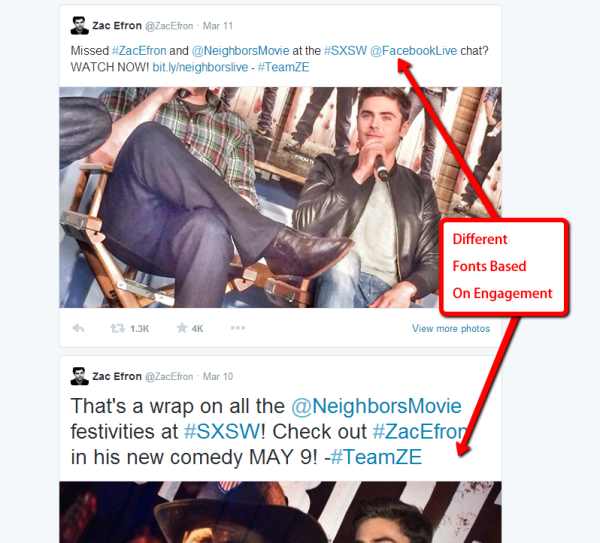
Source: Marketing Land
The new profile design and functionality is currently limited to a small group of prominent users such as Weezer, Zac Efron, & Michelle Obama, but Twitter promises all users will have access in the “coming weeks.”
Online video has reached a new level of importance in our lives over the past few years. YouTube is still the dominant service for free online video hosting and sharing, but several other platforms have taken YouTube’s lead and expanded on it in numerous ways.
Instagram and Vine have imposed limits on their video lengths to make them as sharable as possible, while Vimeo has focused its efforts on hosting primarily high-quality and visually stunning videos instead of the shaky cell-phone footage so prevalent on YouTube.
The question remains, which services do you invest your energy and resources into? If you are hoping to use the social video site to increase your brand’s visibility, you want to tailor the content you are creating to the platform most suited to your demographic.
You can get a complete breakdown of all of the major services in the infographic below.
The graphic was created by Russel Cooke, and explains what makes each service unique, as well as how each could benefit a business. If you know your market, you should be able to identify which service is most likely to connect you with your audience. From there, it’s just a matter of making content that will excite them.


Source: Dashburst.com
It’s no question that social media has become one of the most prominent aspects of online marketing. As Facebook and Twitter have become ingrained in the public consciousness, companies and search engines alike have recognized the value and social media marketing has become intertwined with SEO and advertising to the point that it can be hard to tell where one stops and another begins.
But, as with any new field of marketing, there are bound to be plenty of missteps, gaffes, and wildly ill-advised attempts. For every brand that is killing it on Instagram and Twitter, there are just as many who have found that social media can also magnify your mistakes and make a PR issue into a complete catastrophe.
Thankfully, there is always something to be learned from the mistakes of others. Search Engine Journal recently shared a list of 35 of the most remarkable social media failures in recent history. As they explain, the point isn’t to laugh at those who have made huge mistakes on social media (though it is hard not to laugh at some of the entries). Instead, you should take note of how fine the line is between viral and bad taste, as well as how important it is to keep your cool in times of crisis.
Twitter has become an undeniable force in modern culture. Even if you aren’t signed up for the social media platform, you can hardly turn on the television without being bombarded by tweets and hashtags.
Every major news network solicits tweets from their viewers in order to get real-time responses to issues, and any new episode of a show is bound to have at least one hashtag hovering in the bottom corner of the screen.
But, those TV hashtags highlight one of the biggest problems with Twitter: few people actually understand hashtags or how to use them efficiently. Sure, we all know how to tag Instagram photos with them, or we slap a silly hashtag on the end of tweets to add a little more information, but the number of people actually using hashtags to organize and sort through the constant tidal wave of new tweets is actually quite low.
It isn’t that Twitter’s users aren’t smart enough to use hashtags more efficiently, but it is difficult to make hashtags a very useful sorting device without going through a middleman. Twitter’s search engine can let you broadly search hashtags, but if you want to actually make sense of the mess you most likely need an extra tool to help you out.
Ann Smarty from Search Engine Journal pulled together five such tools to help Twitter users everywhere turn hashtags into a vital part of their information consumption every day. If you want to be smart with your hashtags, these tools are the best place to start.
1. Twitter Chat
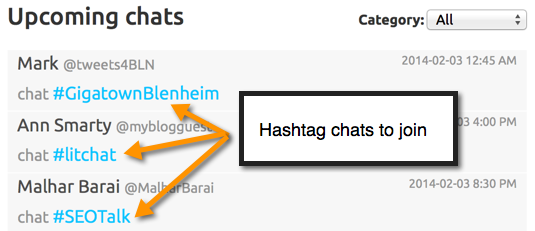
When Twitter began using hashtags, it didn’t take long for users to figure out that the tags can be used to create a conversation between numerous people. Rather than directly messaging an individual, you are able to put a topic or “chat title” in the form of a hashtag so users are able to create a real discussion. But, the conversation was still cluttered and not well laid out for the average reader.
TwChat allows you to take those hashtags and monitor them in real time. It also lays the tweets in a more cohesive way, so that you can more quickly read and understand the conversation. Best of all, it is super simple to use, free, and doesn’t require downloaded software.
2. TagDef

Originally, there was an unspoken rule that hashtags should be easy to understand at a glance. Obviously, this rule has fallen apart over time. Hashtags tend to be a combination of slang, inside jokes, and promotional material that makes no sense without context.
With the help of TagDef, you won’t have to worry about not being caught up with the latest American Idol hashtag or the slang younger people are using to keep up with the meaning behind hashtags popping up in your feed. The tool lets you search a hashtag and get the meaning instantly. You can also edit and add your own meanings. TagDef acts like Urban Dictionary exclusively for hashtags (and potentially a little less focused on profanity).
3. Hashtags
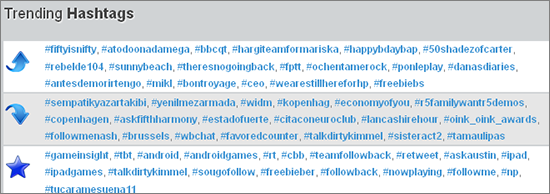
Hashtags gained its reputation as the largest hashtag database on the web, but there is much, much more there. The site includes analytics, how to articles, blog posts, a chatroom, a forum, a hashtag dictionary, events, trending hashtags, popular hashtags (long-term), and even more.
4. Tagboard
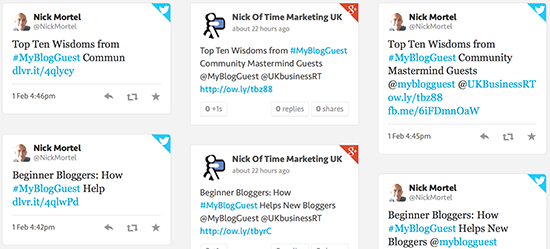
Of course, hashtags aren’t limited strictly to Twitter. The history of hashtags goes all the way back to IRC chats, but they have spread to nearly every major social networking platform out there. Facebook, Instagram, Google+, and Vine have all implemented the organizing tool. Tagboard takes hashtags from across all those different platforms and displaying them all on one page. You can even use it as a social network dashboard, allowing you to like, share, or retweet as you desire without ever having to leave the site.
5. Hashtagify.me
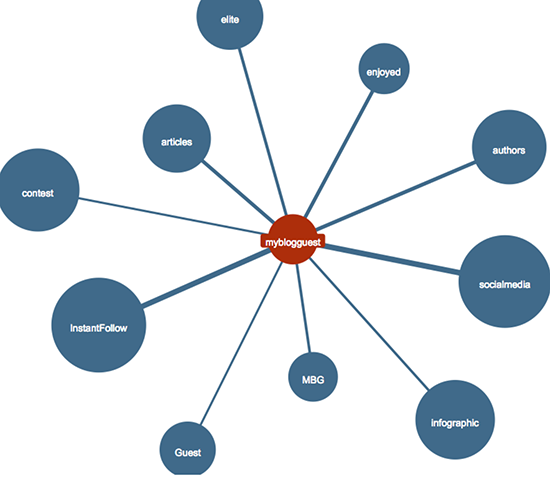
There is no rule you have to use only one hashtag per post. In fact, many add three or more hashtags on a large number of their posts, but it can be hard to see how they are related from Twitter’s site. Hashtagify helps you see how different hashtags are related and their usage patterns, as well as offering in-depth analysis in their pro version. They also have active breakout alerts, so you can always be the first to know about the new cool hashtag.
Explore TMO
From Our Blog
 Everything You Need To Know About Canonical URLs And Your Google RankingsApril 9, 2024 - 5:02 pm
Everything You Need To Know About Canonical URLs And Your Google RankingsApril 9, 2024 - 5:02 pm What’s The Deal With TikTok and Congress?March 14, 2024 - 6:19 pm
What’s The Deal With TikTok and Congress?March 14, 2024 - 6:19 pm



